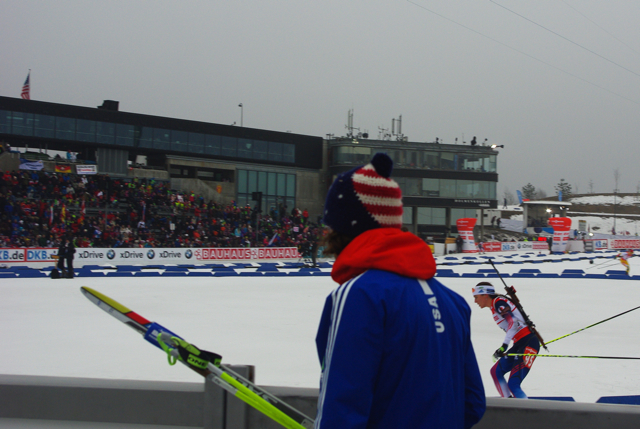
OSLO, Norway– While there were plenty of strong results from North American biathletes in the 7.5 and 10 k World Cup sprints here yesterday, the next biggest story was something more mundane: the horrible, atrocious ski conditions.
Weather has been warm in Oslo during the day, but cold enough at night that there is some ice. That meant that the course conditions were split between ice, slush, and crust that athletes sometimes broke through.
Women’s World Cup leader Kaisa Makarainen of Finland called it “the worst tracks all season” and Norway’s Tora Berger, who is chasing her in the total score, told NRK that it was “quite hopeless to ski in some places.” In Norway it is almost something of a scandal how the trails can be in such bad shape. It’s unclear whether or how much salt was applied to try to freeze up the snow, or whether it was done correctly.
North American athletes agreed with the international leaders, universally panning the course while admitting that it was at least a fair race.
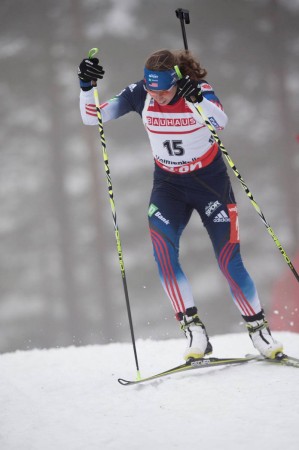
“The course was shitty,” American Hannah Dreissigacker said. “But I think it was equally shitty for everyone.”
“It is not good,” Canada’s Scott Gow agreed. “Some spots are very icy and some spots are very soft, and it’s kind of rutted and bumpy… Some of the corners normally aren’t bad in good conditions, but when you’re taking the corner and you hit a sudden ice patch, it’s kind of hairy.”
“Some of the downhills are pretty scary right now, like the one down there,” teammate Nathan Smith agreed. “You almost fall every time you go around it.”
“My goal going out there today was just, like, stay on your feet and just ski,” said U.S. biathlete Sara Studebaker. “It was really hard to feel like you were racing because the conditions were just so bad.”
“It was really difficult and deep. I just tried to find the icy spots on the course and stay on the hardpacked stuff,” said American Lowell Bailey. “I really focused on trying to work the right technique for the right conditions. They were so varied. So trying to ski pretty big on the uphills when it got deep, and then trying to use the skis to glide on the harder packed V2 sections.”
American Susan Dunklee noted that it could have been worse: “It was pretty abysmal when we showed up today,” she said. “There was really thick fog so you could barely see the targets and then the course must have been six or eight inches deep of slush, all around everywhere. Over the next hour the volunteers really worked on shoveling a lot of stuff off and it got a lot better. But it still was really tough.”
In order of results, here are more comments from the rest of the American and Canadian competitors.
Women’s 7.5 k Sprint
Dunklee led the way in third place, 33 seconds behind race winner Darya Domracheva of Belarus. It was the first World Cup podium for a U.S. woman since 1994; our full story is here.
“I feel like I have been on the edge so many times in the last couple years, that I’m ready to be here,” Dunklee said. “I’m ready to try to do it again in the future. We have a couple more races this weekend and who knows what will happen, and we also have a long summer of training. Going into that with this fresh in my mind will be a very good thing, I think.”
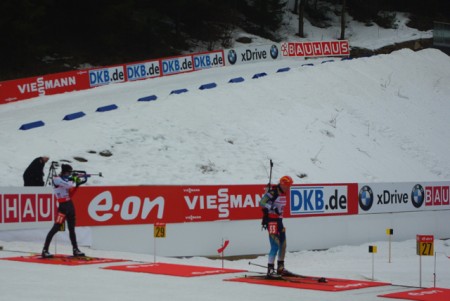
Next came Rosanna Crawford of Canada, who tied for 11th in a career-best result. She wasn’t expecting to do so well, for a variety of reasons.
“I was really in a bad mindset this morning,” Crawford admitted of waking up to find the venue blanketed in thick fog. “My legs were feeling awful and I know I’m not good in these conditions. But I decided to switch and that it was going to be a battle of whoever could overcome the tough conditions and try to have a positive outlook.”
She missed a shot in prone, which immediately bumped her back. But after hearing that Dunklee had cleaned all ten targets and was sitting in third place, Crawford found even more motivation.
“I was like, pfff, if she can hit all her standing targets I can hit all my standing targets,” Crawford laughed. “This is the first season in a while where I’ve been stronger at the end of the season, that hasn’t happened in a while, so that is also motivating.”
Despite the strong results – she was also in the top 20 four times in the past two weeks – Crawford isn’t perfectly pleased with her recent performance and her racing has sparked ideas for change during the off-season.
“I’m bummed that I’m going to end my season without having hit ten for ten once,” she said. “I think that’s the first time ever in my biathlon career… This has been my worst shooting year ever, I think I’m under 80%, which is too bad. So I think the focus over the summer will be of course to get stronger, but to really figure out a good position for my new stock and make sure I’m happy with it.”
Nevertheless, Crawford has collected eight of the best ten results of her career this season, imperfect shooting or no.
“A couple years ago I would have been happy making the top 60 with nine out of ten,” she said. “Now I’m hungry for that top ten, I want to be there, and I want to be there often.”
Teammate Zina Kocher followed in 16th place with two penalties, also continuing a string of good post-Olympic results.
Studebaker of the placed 41st with a single penalty. The Idaho native is retiring at the end of the weekend, and was happy to have a good result and make the pursuit competition in her last weekend of racing.
“I would have said beforehand that I would do great now because I’m not focused on it and not worried about it,” Studebaker said. “But honestly I think I have been more nervous. I am trying not to think about it, but it’s like, ‘this could be my last race, make it good!’ To do everything the same way because it’s working, so just make it happen. But that’s been tough for sure… This trimester has been going pretty well for me, and I wanted to go out in the last race with a bang.”
She finished in a particularly packed part of the field, and was happy with how she was able to ski on her final loop.
“When I was out there I was getting good splits that I was in the high 30’s, but that ten seconds would have been 50th,” she said. “You gotta push and it’s crazy when it’s that close. I wasn’t totally able to hold onto the points… I was happy with how things went.”
Canada’s Megan Heinicke, racing with a rib injury, placed 59th with three penalties and actually fainted at the finish line.
Dreissigacker collected five penalties, two in prone and three in standing, and placed 75th to miss the cutoff for Saturday’s pursuit competition. Her race started off well, thanks to Dunklee.
“I was about to start as she was coming into the finish, and I was so distracted, like, I just want to watch!” Dreissigacker said. “Right as I was leaving I heard her going into third place, and I was psyched. During my race I heard them interview her on the loudspeaker, which was pretty cool.”
But things on the range were difficult
“I was really hoping that I could have a good one too,” she lamented. “I don’t know, I just hate shooting sometimes – there’s just no reason I should shoot that badly. Practice yesterday was so good. I missed like one shot the whole day. It was feeling so good, and I just don’t get it.”
Men’s 10 k Sprint
Bailey led the way for the North American men, finishing 18th. After hitting the podium for the first time in his career last week, he knew what would have been possible if he had shot better than his two penalties.
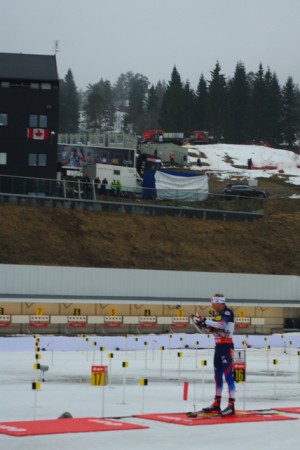
“My skiing was good today,” he said. “I was skiing top of the field. So I just let two go. But I think it will be hopefully a decent result. I think I was about a minute off with two penalties, so it could have been another good day if I had put it together on the range.”
Bailey said that despite his own podium last week and having watched Dunklee’s performance before his own race, he tried not to let expectations creep into his head.
“I just tried to keep my head in the game and really focus on what I could control today,” he explained. “I worked on being aggressive on the range this week leading into this. I’m not disappointed, I hoped for better, but that’s biathlon, some days are better than others.”
All three Canadian men qualified for the 60-man pursuit to be held on Saturday. They were led by Gow, who placed 35th with clean shooting.
“That felt awesome!” a radiant Gow said at the finish. “I think it’s actually my first clean sprint race of the year, so it could not have come at a better time I don’t think.”
Next came Brendan Green, who placed 47th with two penalties. He was followed by Nathan Smith in 50th place, also with two penalties.
“I didn’t feel that great skiing really,” Smith said. “I wasn’t able to keep up to most guys. I just felt a bit tired… Shooting eight, you need to get more than that to get your best result.”
United States teammates Tim Burke, Leif Nordgren, and Sean Doherty all struggled with shooting, missing four shots apiece. Burke narrowly missed making the pursuit, finishing 64th. Nordgren placed 78th and Doherty, who is coming off a World Junior Championships where he won two gold and one silver medal, finished 83rd.
“Ouch! Fitting ending for a less than spectacular season…” Nordgren tweeted after the competition.
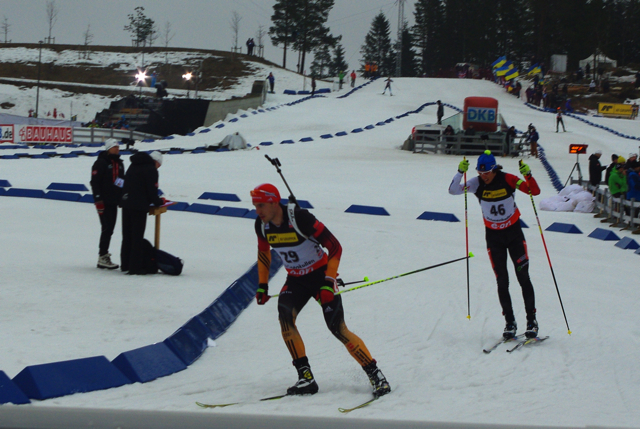
Chelsea Little
Chelsea Little is FasterSkier's Editor-At-Large. A former racer at Ford Sayre, Dartmouth College and the Craftsbury Green Racing Project, she is a PhD candidate in aquatic ecology in the @Altermatt_lab at Eawag, the Swiss Federal Institute of Aquatic Science and Technology in Zurich, Switzerland. You can follow her on twitter @ChelskiLittle.



